The Ruffed Grouse (Bonasa umbellus) is a small, chicken-like bird with mottled brown and gray plumage, a short crest, and a longish, fan-like tail.
This bird can be seen in forests in Alaska, Canada, parts of the northern USA, and the Appalachians.
Ruffed Grouse are fairly common but typically shy. We usually hear their low-pitched thumping sound much more than we see them. However, if you carefully scan forested roads and trails in the early morning, you might see one of these special birds.
On this page
Identification
The Ruffed Grouse is a slender, chicken-sized bird with a stubby dark beak, short crest, rounded wings, and black bars on its pale sides.
It also has short, feathered legs and feet, is around 17 inches long, has a wingspan of 22 inches, and weighs 1.3 pounds.
Male Ruffed Grouse are slightly larger than females, but the differences are too small to notice. The males have heavily mottled gray and brown plumage and can be mostly gray, red-brown, or a blend of these colors.
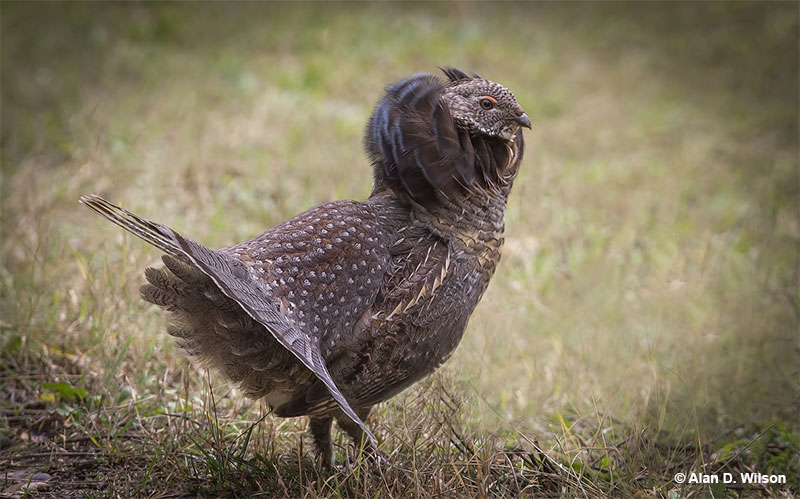
They tend to be paler on the throat and underparts, and have a longish, fan-shaped tail with a thick, black tip.
When displaying, male Ruffed Grouse usually stands on a log, show and raise black “ruff” feathers on their neck, spread and raise their tail like a fan, and quickly beat their wings.
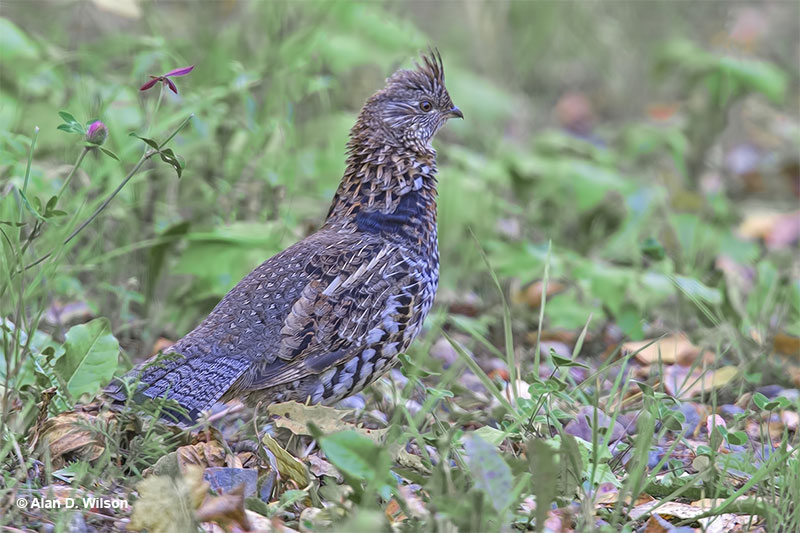
Female
Female Ruffed Grouse look similar but have a shorter crest and tail, and the black tip on their tail is broken. They also have less black on their neck, and have fewer white spots on their rump.
Only males drum; a very low-pitched sound that increases in tempo and is sort of like a motor starting up. Both sexes also occasionally make clucking and squealing calls.
Food
For the most part, Ruffed Grouse are vegetarians. Although young birds and adults in summer can eat some invertebrates, this species is very much adapted to feeding on vegetable material. They do all of their foraging in forest, especially young forests, and eat catkins, various tree buds, berries, and other plant matter.
In summer, the Ruffed Grouse eats herbaceous plants, ferns, and lots of soft fruits. They can forage alone, but after breeding, Ruffed Grouse can form small groups that feed together on the forest floor.
In winter, this species does a lot more foraging in trees. Although birds in the southern part of their range can still do a good amount of their winter foraging on the ground, in northern regions with deep snow, they mostly rely on the buds and twigs of Aspens.
It prefers the flowering buds of Quaking Aspen but also eats buds on Willows and other tree species.
When foraging for tree buds, Ruffed Grouse perch high in the tree and use their beaks to pick buds the same way most birds eat berries. Ruffed Grouse forage on the ground for other types of food by carefully walking along and using their beaks to pick berries and plant matter.
Nesting and Eggs
In spring, the male Ruffed Grouse frequently makes its drumming sound to find a mate. After the female chooses a mate, she starts making her nest a few days to a week later.
She picks a spot in open hardwood forest where she can more easily spot predators and scrapes out a shallow, bowl-like depression on the ground.
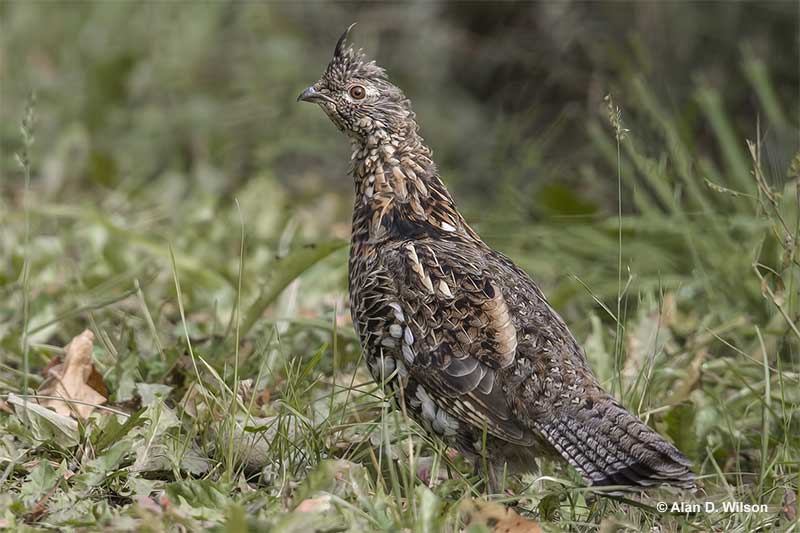
The female Ruffed Grouse usually makes her nest next to a boulder, log, or tree stump but can also nest in a brush pile. She lays 9 to 14 cinnamon or buff-colored eggs with some small dark speckling. The eggs are 1.5 inches long and weigh .7 ounces.
For the next two weeks, she sits low on the nest to incubate her eggs. The female briefly leaves the nest five times per day to feed or defecate but spends all of the rest of her time sitting on her eggs.
After hatching, the baby grouse leave the nest 24 hours later and follow their mother to a more protected spot with dense vegetation and food.
The young birds find their own food but stay with their mother for 12 weeks after hatching. After that time, they become independent and go off on their own.
Current Situation
The Ruffed Grouse is a permanent resident of forests in central Alaska, in most forested areas of Canada, and in the Pacific Northwest south to California. It also lives in the Rocky Mountains south to Utah, around the Great Lakes, at scattered sites in the Midwest, and in the northeastern USA and Appalachian region.
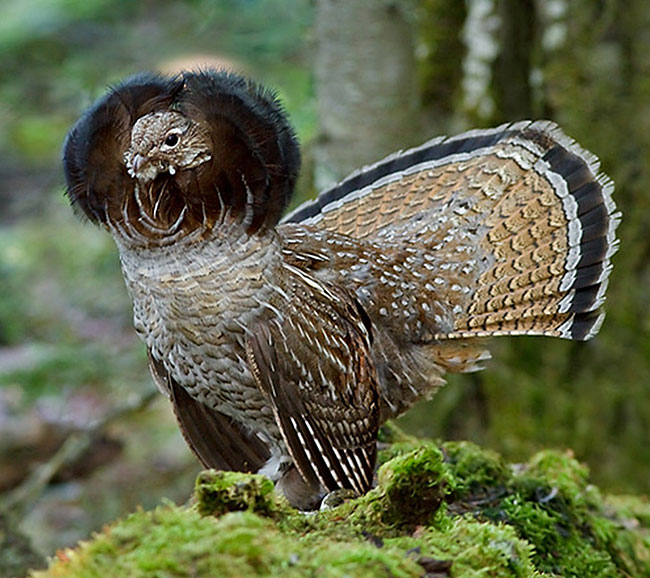
This species is listed as Least Concern in the IUCN Red List and is a common bird in most parts of its range.
However, in many parts of the Midwest, Ruffed Grouse occur in small and local populations that could easily be extirpated by uncontrolled hunting and forest fragmentation.
In most other regions in their natural range, as long as enough forest is present, Ruffed Grouse are common birds.
Although they are hunted in many areas, they don’t seem to be affected by managed hunting. They also increase in numbers when young forests are created by fire and some degree of logging.
Facts
- In much of its range, this bird depends on snow for roosting. To survive cold nights, Ruffed Grouse bury themselves in soft snow and become insulated from low temperatures. In parts of their range that lack deep snow, they roost in dense stands of evergreens.
- Ruffed Grouse have adaptations that help them eat and digest tree buds with chemical compounds toxic to most other birds and animals.
- In winter, Ruffed Grouse have comb-like structures on the sides of the toes. In helping them walk on top of snow, these structures act like snowshoes.
- The drumming sound that male Ruffed Grouse make is created by rushing air quickly displaced as they beat their wings back and forth.
- This species goes through cycles where it increases and decreases in numbers every ten or so years. They occur in high numbers when there are a lot of Snowshoes Hares for Northern Goshawks and other predators to feed on. However, when hare numbers are low, Ruffed Grouse numbers decline as the predators catch more of them.
Similar Species
The Ruffed Grouse is a distinctive bird in most of its range. However, there are a few species it could be potentially confused with.
Dusky Grouse and Sooty Grouse
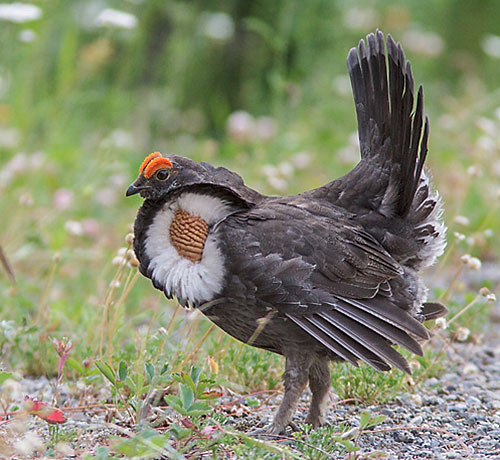
Sooty Grouse
The females of these two species could be confused with a Ruffed Grouse but are larger, more uniform dark gray-brown birds. The Ruffed Grouse is also paler below and has bold black bars on its sides.
In addition, female Dusky and Sooty Grouses do not have a thick black tip on their tails.
Spruce Grouse
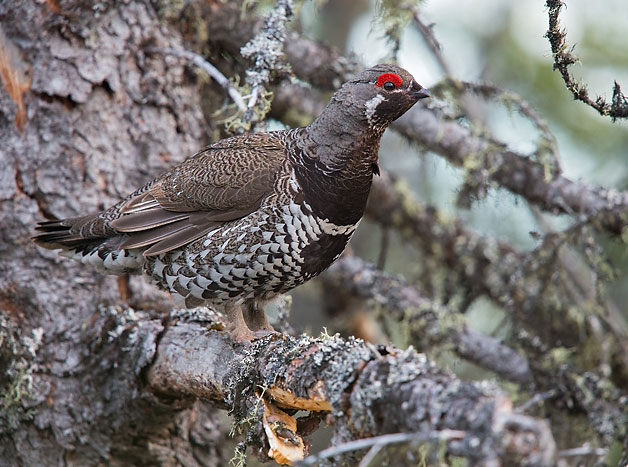
The female Spruce Grouse is another, similar-sized grouse with mottled brown plumage. However, it has more uniformly-colored plumage and fine dark barring on its underparts.
This bird also has a shorter, dark tail that lacks the black tip shown by the Ruffed Grouse.
Sharp-tailed Grouse
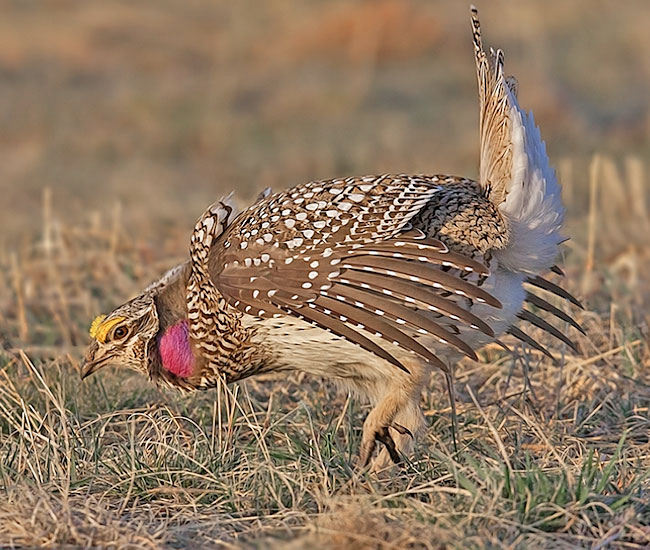
The Sharp-tailed Grouse is the same size as a Ruffed Grouse and has a short crest but is paler gray-brown. It also has more spotting on its upperparts and has a buff belly with scattered small dark markings.
Most of all, this species has a pale, pointed tail.
Frequently Asked Questions
What is special about a Ruffed Grouse?
A Ruffed Grouse is special because it can survive in cold climates by flying into snow drifts to roost there for the night. It also has fringes on its outer toes that help it walk on top of snow like snow shoes!
Can a Ruffed Grouse fly?
Yes, Ruffed Grouse can fly. When flushed, they burst into flight and quickly fly into cover.
What state has the most Ruffed Grouse?
Minnesota and Alaska are the states with the most Ruffed Grouse.
Can grouse be aggressive?
Yes, once in a while, Ruffed Grouse become tame and aggressive with people on their territories. Odd birds have chased and even pecked people.


